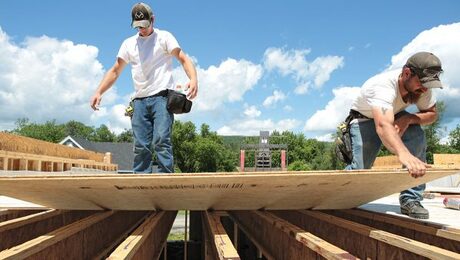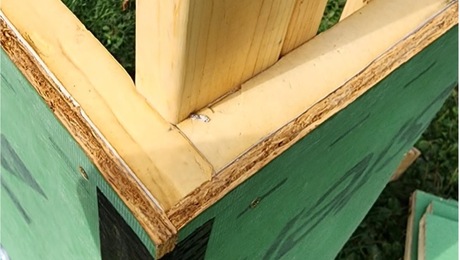Unvented Cathedral Ceiling with Drywall Gaps in Ceiling – Am I at Risk of Batt Insulation Particle Exposure?
Hello, I’m a homeowner (not a builder) that is hoping for insight from the experienced builders on this forum to help put my mind at ease.
In 2022, I purchased a new construction home in Central Oregon (climate zone 5). The house has a modern design which involves a great room ceiling that is continuously sloped from one wall to the other. There are several 6×12″ wood beams that span across the ceiling, running in the same direction as the slope. There is no attic above. The exterior roof line parallels the ceiling, with about 12″ between them (as viewed from the outside). Notably, there aren’t any intake or soffit vents on the exterior eaves. So, I believe this is what is known as an “unvented roof assembly with cathedral ceiling”.
Here is my concern: when I look at the ceiling , I can see small gaps (up to about 1/8″) along the length of some of the beams at the seam where they meet up with the ceiling drywall. I worry that these gaps could provide a passage for insulation particles to enter into the living room. To be clear, I do not know what insulation is on the other side of the drywall, but other homes in the neighborhood use batt insulation. For the sake of this discussion, let’s assume it’s batt insulation. My understanding of the building code (IRC section R806.5 #2) for unvented cathedral roof assemblies in climate zone 5 is that air/vapor plastic retarders are not allowed on the ceiling side, so as to allow drying of any moisture from the interior. If so, would this mean that the aforementioned gaps could in fact be a passage by which insulation particles could enter into the living space? Or is there required to be some sort of barrier between batt insulation and the ceiling drywall, even with an unvented roof assembly.
I’d greatly appreciate insights from the experts on this. I haven’t been sleeping well lately because of the fear that insulation particles could be entering the great room from above. I realize that the presence of a passage wouldn’t necessarily mean that particles are coming down, but nonetheless, I would very much prefer there was zero opportunity for them to enter so that I don’t even have to wonder.
Also, please let me know if I can provide any additional information.
Thank you so very much!
Sarah
GBA Detail Library
A collection of one thousand construction details organized by climate and house part









Replies
Sarah,
Rather than guess how the roof is built and whether there is actually a problem, why not run a bead of caulking along the edge of the drywall to seal it to the beam? That way you won't have to worry about it, and whatever the roof construction, air-sealing those gaps will be beneficial for it too.
Hi Malcolm, while that is an option I've considered, I'm extremely hesitant to take any such action. One thing I've learned from my past is that the "do-nothing" option can be better (and less regrettable) than taking action. There are 12 beams, each about 20-ft long, with 2 sides/seams, so we're talking 480 lineal feet. That's a lot to caulk. And if not done perfectly, it introduces risks of needing to re-paint, etc, only expanding the work and risks (since the original paint was sprayed on, but any touch-ups would be done by hand and thus 'lay down' differently). I guess what I'm saying it - I'd like to pursue the path of discussing and understanding the risk before taking any action :)
The required barrier is the drywall. It should be continuous and air-tight.
A roof like that with fiberglass should have vents at the soffit and ridge, and a vent channel between the roof and the insulation. The ceiling should be as air-tight as possible and there should be a vapor retarder between the ceiling and the drywall. Given the vintage it probably wasn't done properly.
Caulking is a low-risk first step, it won't make anything worse and will probably help.
Hi, thanks for your reply but I'm confused by several aspects.
What I do know for a fact is that the roof assembly is un-vented. What I don't know is how it's insulated. Considering it's unvented (and is only 12" deep, and constructed in 2022), do you think it's unlikely to have batt insulation in the ceiling?
What do you mean by "there should be a vapor retarder between the ceiling and drywall"? The ceiling is the drywall. Also, my understanding of the code (please correct me if I'm wrong) is that you're not supposed to have a vapor barrier between the ceiling and insulation for unvented roof assemblies.
And what do you mean "given the vintage, it probably wasn't done properly." It was built in 2022.
For some reason I thought you had said it was from the 1980's.
If it is 2022, there is a chance that the insulation is spray foam. That's really the only insulation that can properly be used in an unvented roof. If that's the case then, yes, you don't want a vapor retarder. And air sealing becomes less important.
You still should have continuous drywall. Spray foam is a fire risk, it needs to be covered by a fireproof material and that's usually done with drywall.
Do you have lights or smoke detectors in your ceiling? Usually you can take one down and look behind it and see what kind of insulation you have.
The drywall is "mostly" continuous. At the seams where the ceiling (drywall) and beams meet, there is a small gap along the length of the beam. The gap is the thickness of a couple credit cards, < 1/8". I'm not a drywall expert, but I think a small gap might be somewhat inevitable due to the nature of having beams, i.e. they interrupt the ability to place drywall panels adjacent to each other and tape up the seams, as would occur in a normal ceiling. The YouTube videos I've watched where drywall is installed abutting exposed beams using TearAway Bead Vinyl Flange still leave a similarly small gap afterwards. Is this still considered "continuous" drywall?
Given the installation year of 2022, is it possible or probable that 100% of the insulation is spray foam (as opposed to a "flash-and-batt method")?
If all insulation is infact spray foam, would the small gaps (< 1/8") at the ceiling/beam seams be considered adequately protective against any health hazards posed by the spray foam?
I have recessed can lights. But not sure if I can see anything if I remove a light bulb, since the metal can blocks my view.
I really appreciate your help!
Recess lights are usually just held to the drywall with clips, you can pop them out pretty easily. Especially the newer LED ones.